traction control CADILLAC CTS 2008 2.G User Guide
[x] Cancel search | Manufacturer: CADILLAC, Model Year: 2008, Model line: CTS, Model: CADILLAC CTS 2008 2.GPages: 490, PDF Size: 2.59 MB
Page 274 of 490

Traction Control System (TCS)
Your vehicle has a Traction Control System (TCS) that
limits wheel spin. This is especially useful in slippery
road conditions. It will activate and the TCS/StabiliTrak
®
light will �ash if it senses that any of the wheels are
spinning or beginning to lose traction while driving.
When this happens, the system applies the brake to
the spinning wheel(s) and/or reduces engine power to
limit wheel spin. The TCS/StabiliTrak warning light
will �ash when the traction control system is limiting
wheel spin.
You may feel or hear the system working, but this is
normal.
This warning light will
come on if there is a
problem with the traction
control system.SeeTraction Control System (TCS)/StabiliTrak
®
Warning Light on page 3-39andStabiliTrak®System on
page 4-8. When the TCS/StabiliTrak warning light is
on, the system will not limit wheel spin. Adjust your
driving accordingly.
TCS automatically comes on whenever the vehicle is
started. To limit wheel spin, especially in slippery road
conditions, you should always leave the system on. But
the TCS should be turned off if your vehicle ever gets
stuck in sand, mud or snow and rocking the vehicle is
required. Also, turn the TCS off while in deep snow or on
loose gravel, to assist vehicle motion at lower speeds.
SeeRocking Your Vehicle to Get It Out on page 4-22for
more information. See alsoWinter Driving on page 4-17
for information on using TCS when driving in snowy or icy
conditions.
Press the TC (Traction
Control) button, located on
the instrument panel, to
turn the system off.
4-6
Page 275 of 490

If you press the TC button once, the traction control
system will turn off and the TCS/StabiliTrak Warning
Light will come on. Press the TC button again to turn
the system back on. Press and hold the TC button for
�ve seconds or longer, to turn the StabiliTrak system off.
The TCS/StabiliTrak warning light will come on. Press
the TC button again to turn Stabilitrak back on. For more
information, seeStabiliTrak
®System on page 4-8.
Adding non-dealer/non-retailer accessories can affect
your vehicleâs performance. SeeAccessories and
Modiï¬cations on page 5-4for more information.
Competitive Driving Mode
Press the TC button quickly two times to select this
optional handling mode. The StabiliTrak Competitive
Mode message displays in the Driver Information Center
(DIC). While in the StabiliTrak Competitive Mode, TCS
does not operate, and the TCS warning light comes on.
Adjust your driving accordingly.Press the TC button again, or turn the ignition to
ACC/ACCESSORY, to turn the TCS back on and the
TCS warning light off.
Notice:When traction control is turned off, or
Competitive Driving Mode is active, it is possible to
lose traction. If you attempt to shift with the rear
wheels spinning with a loss of traction, it is possible
to cause damage to the transmission. Do not attempt
to shift when the rear wheels do not have traction.
Damage caused by misuse of the vehicle is not
covered. See your warranty book for additional
information.Limited-Slip Rear Axle
Your vehicle may have this feature. A limited-slip rear
axle can give you additional traction on snow, mud, ice,
sand or gravel. It works like a standard axle most of
the time, but when one of the rear wheels has no
traction and the other does, this feature will allow the
wheel with traction to move the vehicle.
4-7
Page 276 of 490

StabiliTrak®System
The vehicle has an electronic stability control system
called StabiliTrak. It is an advanced computer controlled
system that assists with directional control of the
vehicle in difficult driving conditions.
StabiliTrak activates when the computer senses a
discrepancy between your intended path and the
direction the vehicle is actually traveling. StabiliTrak
selectively applies braking pressure at any one of the
vehicleâs brakes to help steer the vehicle in the direction
which you are steering.
When the system activates, the Traction Control System
(TCS)/StabiliTrak warning light on the instrument
panel cluster �ashes. You may also hear a noise or feel
vibration in the brake pedal. This is normal. Continue
to steer the vehicle in the direction you want it to go.
If there is a problem detected with StabiliTrak, a Service
Stability System message displays on the Driver
Information Center (DIC) and the TCS/StabiliTrakwarning light on the instrument panel cluster comes on.
When this message and warning light displays, the
system is not operational. Driving should be adjusted
accordingly. SeeDIC Warnings and Messages on
page 3-56andWarning Lights, Gages, and Indicators
on page 3-30for more information.
StabiliTrak comes on automatically whenever the vehicle
is started. The system should be left on to help assist with
directional control of the vehicle. If StabiliTrak needs to
be turned off, press the TC (traction control) on/off button.
SeeTraction Control System (TCS) on page 4-6.
If cruise control is being used when the StabiliTrak
activates, the cruise control will automatically disengage.
When road conditions allow, reengage the cruise
control. SeeCruise Control on page 3-14for more
information.
4-8
Page 277 of 490

Panic Brake Assist
Your vehicle has a panic brake assist system that
monitors the intention of the driver while braking. If the
system senses that the driver has applied hard/fast
pressure to the brake pedal, the system will generate
additional pressure, making it easier for the driver to
maintain brake application. When this happens the brake
pedal will feel easier to push. Just hold the brake pedal
down �rmly and let the system work for you. You may feel
the brakes vibrate, or you may notice some noise but this
is normal. The brakes will return to normal operation after
the brake pedal has been released.
All-Wheel Drive (AWD) System
If your vehicle has this feature, the AWD system will
automatically monitor and adjust engine power to
the front and rear wheels for the best traction and
handling. If there is a loss of traction or stability,
the AWD system works with the Electronic Stability
Control (ESC) system to increase power to the
front wheels as necessary.
If the spare tire is on the vehicle, there may be a slight
reduction in performance of the AWD system.
SeeDIC Warnings and Messages on page 3-56for
AWD related DIC messages.
Steering
Power Steering
If you lose power steering assist because the engine
stops or the system is not functioning, you can steer but
it will take much more effort.
Speed Variable Assist Steering
Your vehicle has a steering system that varies the
amount of effort required to steer the vehicle in relation
to the speed of the vehicle.
The amount of steering effort required is less at slower
speeds to make the vehicle more maneuverable
and easier to park. At faster speeds, the steering effort
increases to provide a sport-like feel to the steering.
This provides maximum control and stability.
If your vehicle seems harder to steer than normal when
parking or driving slowly, there may be a problem
with the system. You will still have power steering, but
steering will be stiffer than normal at slow speeds.
See your dealer/retailer for service.
4-9
Page 278 of 490
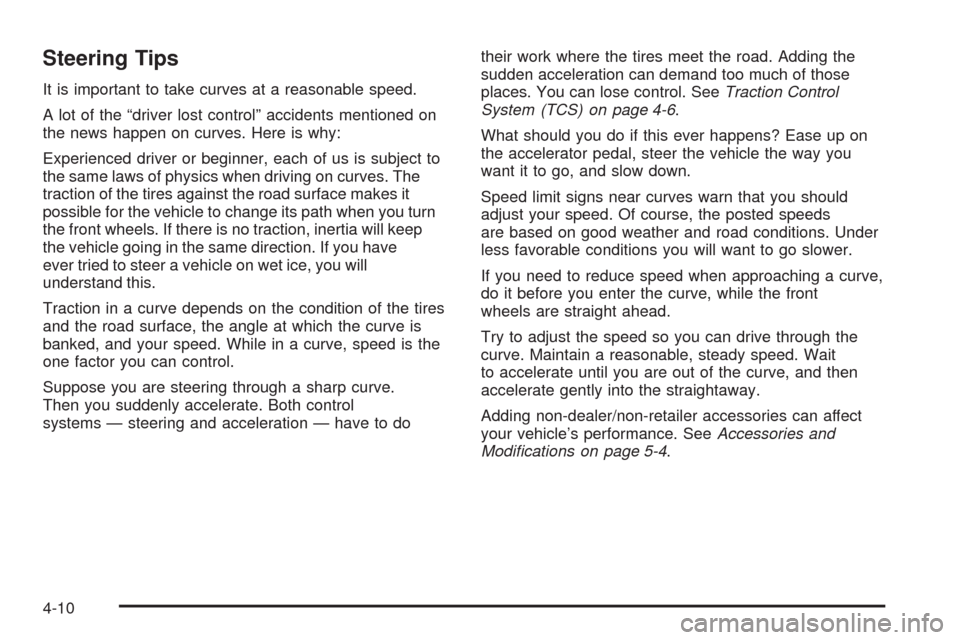
Steering Tips
It is important to take curves at a reasonable speed.
A lot of the âdriver lost controlâ accidents mentioned on
the news happen on curves. Here is why:
Experienced driver or beginner, each of us is subject to
the same laws of physics when driving on curves. The
traction of the tires against the road surface makes it
possible for the vehicle to change its path when you turn
the front wheels. If there is no traction, inertia will keep
the vehicle going in the same direction. If you have
ever tried to steer a vehicle on wet ice, you will
understand this.
Traction in a curve depends on the condition of the tires
and the road surface, the angle at which the curve is
banked, and your speed. While in a curve, speed is the
one factor you can control.
Suppose you are steering through a sharp curve.
Then you suddenly accelerate. Both control
systems â steering and acceleration â have to dotheir work where the tires meet the road. Adding the
sudden acceleration can demand too much of those
places. You can lose control. SeeTraction Control
System (TCS) on page 4-6.
What should you do if this ever happens? Ease up on
the accelerator pedal, steer the vehicle the way you
want it to go, and slow down.
Speed limit signs near curves warn that you should
adjust your speed. Of course, the posted speeds
are based on good weather and road conditions. Under
less favorable conditions you will want to go slower.
If you need to reduce speed when approaching a curve,
do it before you enter the curve, while the front
wheels are straight ahead.
Try to adjust the speed so you can drive through the
curve. Maintain a reasonable, steady speed. Wait
to accelerate until you are out of the curve, and then
accelerate gently into the straightaway.
Adding non-dealer/non-retailer accessories can affect
your vehicleâs performance. SeeAccessories and
Modiï¬cations on page 5-4.
4-10
Page 281 of 490

Skidding
In a skid, a driver can lose control of the vehicle.
Defensive drivers avoid most skids by taking reasonable
care suited to existing conditions, and by not overdriving
those conditions. But skids are always possible.
The three types of skids correspond to your vehicleâs
three control systems. In the braking skid, the wheels are
not rolling. In the steering or cornering skid, too much
speed or steering in a curve causes tires to slip and lose
cornering force. And in the acceleration skid, too much
throttle causes the driving wheels to spin.
A cornering skid is best handled by easing your foot off
the accelerator pedal.
Remember: Any traction control system helps avoid only
the acceleration skid. If your traction control system is
off, then an acceleration skid is also best handled
by easing your foot off the accelerator pedal.
If your vehicle starts to slide, ease your foot off the
accelerator pedal and quickly steer the way you want
the vehicle to go. If you start steering quickly enough,
your vehicle may straighten out. Always be ready
for a second skid if it occurs.Of course, traction is reduced when water, snow, ice,
gravel, or other material is on the road. For safety,
you will want to slow down and adjust your driving to
these conditions. It is important to slow down on slippery
surfaces because stopping distance will be longer and
vehicle control more limited.
While driving on a surface with reduced traction, try
your best to avoid sudden steering, acceleration,
or braking, including reducing vehicle speed by shifting
to a lower gear. Any sudden changes could cause
the tires to slide. You may not realize the surface
is slippery until your vehicle is skidding. Learn to
recognize warning clues â such as enough water, ice,
or packed snow on the road to make a mirrored
surface â and slow down when you have any doubt.
Remember: Any Antilock Brake System (ABS) helps
avoid only the braking skid.
4-13
Page 283 of 490
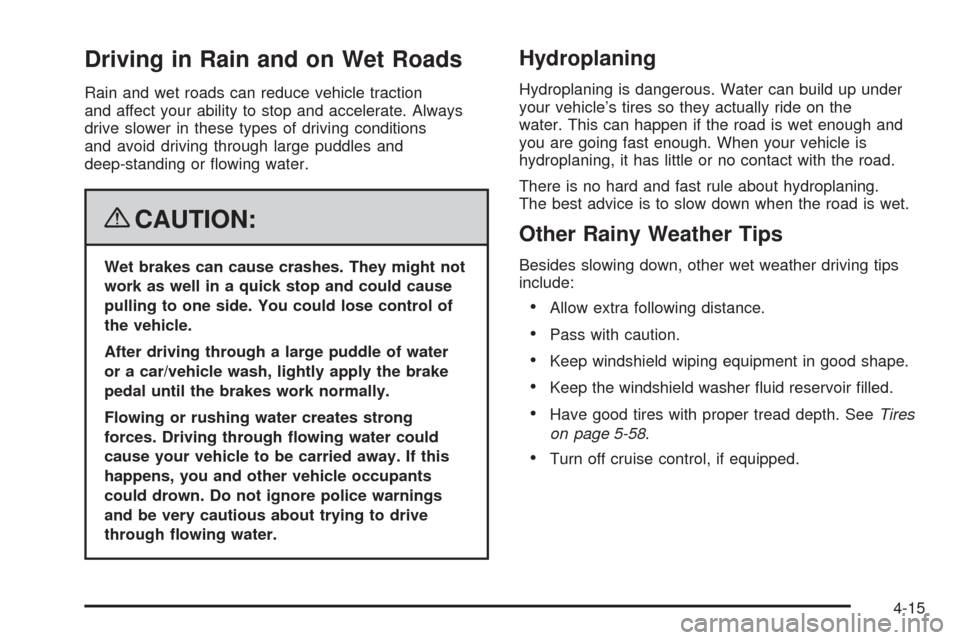
Driving in Rain and on Wet Roads
Rain and wet roads can reduce vehicle traction
and affect your ability to stop and accelerate. Always
drive slower in these types of driving conditions
and avoid driving through large puddles and
deep-standing or �owing water.
{CAUTION:
Wet brakes can cause crashes. They might not
work as well in a quick stop and could cause
pulling to one side. You could lose control of
the vehicle.
After driving through a large puddle of water
or a car/vehicle wash, lightly apply the brake
pedal until the brakes work normally.
Flowing or rushing water creates strong
forces. Driving through �owing water could
cause your vehicle to be carried away. If this
happens, you and other vehicle occupants
could drown. Do not ignore police warnings
and be very cautious about trying to drive
through �owing water.
Hydroplaning
Hydroplaning is dangerous. Water can build up under
your vehicleâs tires so they actually ride on the
water. This can happen if the road is wet enough and
you are going fast enough. When your vehicle is
hydroplaning, it has little or no contact with the road.
There is no hard and fast rule about hydroplaning.
The best advice is to slow down when the road is wet.
Other Rainy Weather Tips
Besides slowing down, other wet weather driving tips
include:
Allow extra following distance.
Pass with caution.
Keep windshield wiping equipment in good shape.
Keep the windshield washer �uid reservoir �lled.
Have good tires with proper tread depth. SeeTires
on page 5-58.
Turn off cruise control, if equipped.
4-15
Page 286 of 490
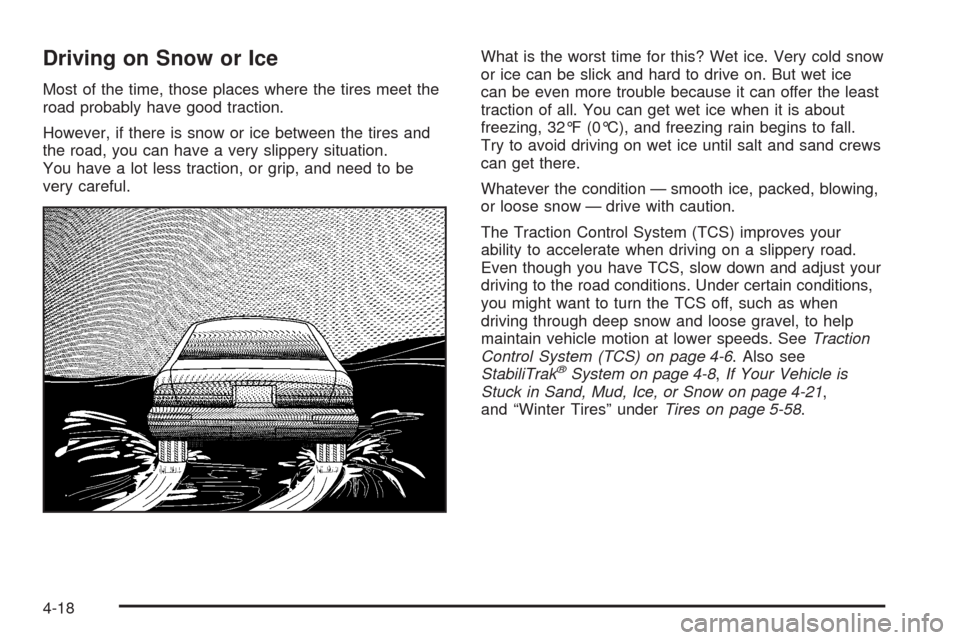
Driving on Snow or Ice
Most of the time, those places where the tires meet the
road probably have good traction.
However, if there is snow or ice between the tires and
the road, you can have a very slippery situation.
You have a lot less traction, or grip, and need to be
very careful.What is the worst time for this? Wet ice. Very cold snow
or ice can be slick and hard to drive on. But wet ice
can be even more trouble because it can offer the least
traction of all. You can get wet ice when it is about
freezing, 32°F (0°C), and freezing rain begins to fall.
Try to avoid driving on wet ice until salt and sand crews
can get there.
Whatever the condition â smooth ice, packed, blowing,
or loose snow â drive with caution.
The Traction Control System (TCS) improves your
ability to accelerate when driving on a slippery road.
Even though you have TCS, slow down and adjust your
driving to the road conditions. Under certain conditions,
you might want to turn the TCS off, such as when
driving through deep snow and loose gravel, to help
maintain vehicle motion at lower speeds. SeeTraction
Control System (TCS) on page 4-6. Also see
StabiliTrak
®System on page 4-8,If Your Vehicle is
Stuck in Sand, Mud, Ice, or Snow on page 4-21,
and âWinter Tiresâ underTires on page 5-58.
4-18
Page 290 of 490
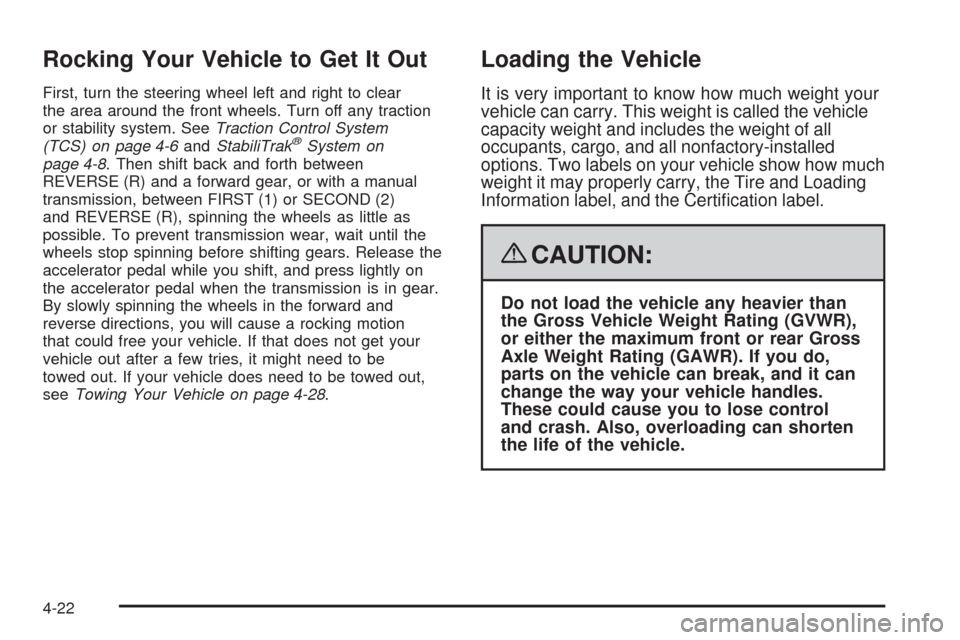
Rocking Your Vehicle to Get It Out
First, turn the steering wheel left and right to clear
the area around the front wheels. Turn off any traction
or stability system. SeeTraction Control System
(TCS) on page 4-6andStabiliTrak
®System on
page 4-8. Then shift back and forth between
REVERSE (R) and a forward gear, or with a manual
transmission, between FIRST (1) or SECOND (2)
and REVERSE (R), spinning the wheels as little as
possible. To prevent transmission wear, wait until the
wheels stop spinning before shifting gears. Release the
accelerator pedal while you shift, and press lightly on
the accelerator pedal when the transmission is in gear.
By slowly spinning the wheels in the forward and
reverse directions, you will cause a rocking motion
that could free your vehicle. If that does not get your
vehicle out after a few tries, it might need to be
towed out. If your vehicle does need to be towed out,
seeTowing Your Vehicle on page 4-28.
Loading the Vehicle
It is very important to know how much weight your
vehicle can carry. This weight is called the vehicle
capacity weight and includes the weight of all
occupants, cargo, and all nonfactory-installed
options. Two labels on your vehicle show how much
weight it may properly carry, the Tire and Loading
Information label, and the Certi�cation label.
{CAUTION:
Do not load the vehicle any heavier than
the Gross Vehicle Weight Rating (GVWR),
or either the maximum front or rear Gross
Axle Weight Rating (GAWR). If you do,
parts on the vehicle can break, and it can
change the way your vehicle handles.
These could cause you to lose control
and crash. Also, overloading can shorten
the life of the vehicle.
4-22
Page 310 of 490
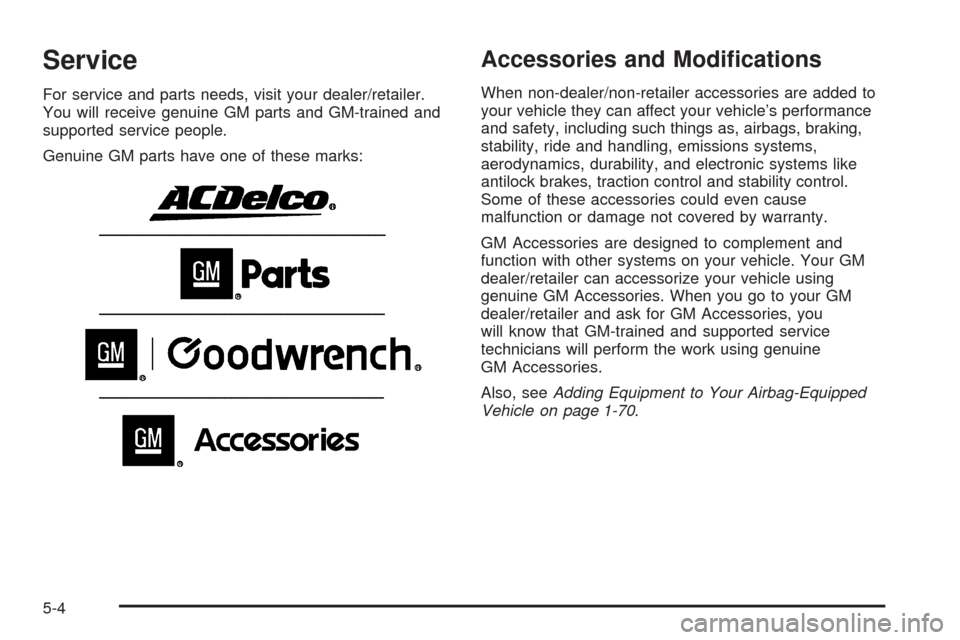
Service
For service and parts needs, visit your dealer/retailer.
You will receive genuine GM parts and GM-trained and
supported service people.
Genuine GM parts have one of these marks:
Accessories and Modi�cations
When non-dealer/non-retailer accessories are added to
your vehicle they can affect your vehicleâs performance
and safety, including such things as, airbags, braking,
stability, ride and handling, emissions systems,
aerodynamics, durability, and electronic systems like
antilock brakes, traction control and stability control.
Some of these accessories could even cause
malfunction or damage not covered by warranty.
GM Accessories are designed to complement and
function with other systems on your vehicle. Your GM
dealer/retailer can accessorize your vehicle using
genuine GM Accessories. When you go to your GM
dealer/retailer and ask for GM Accessories, you
will know that GM-trained and supported service
technicians will perform the work using genuine
GM Accessories.
Also, seeAdding Equipment to Your Airbag-Equipped
Vehicle on page 1-70.
5-4